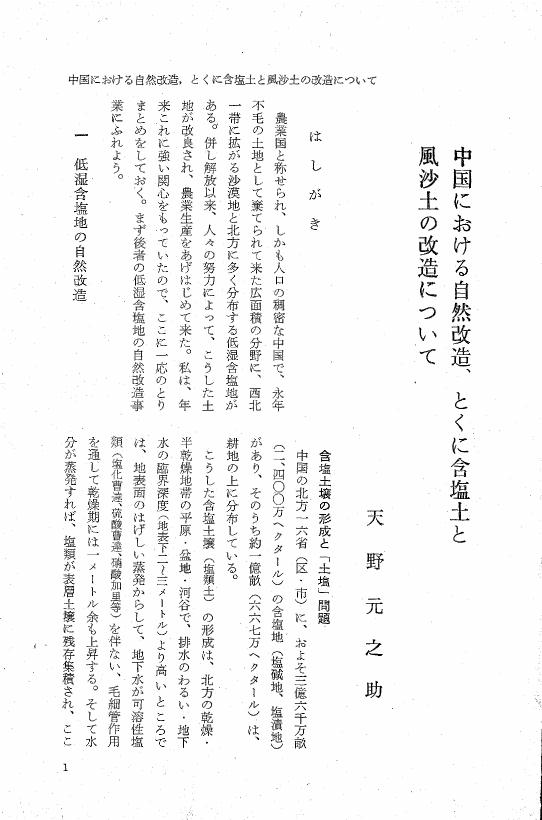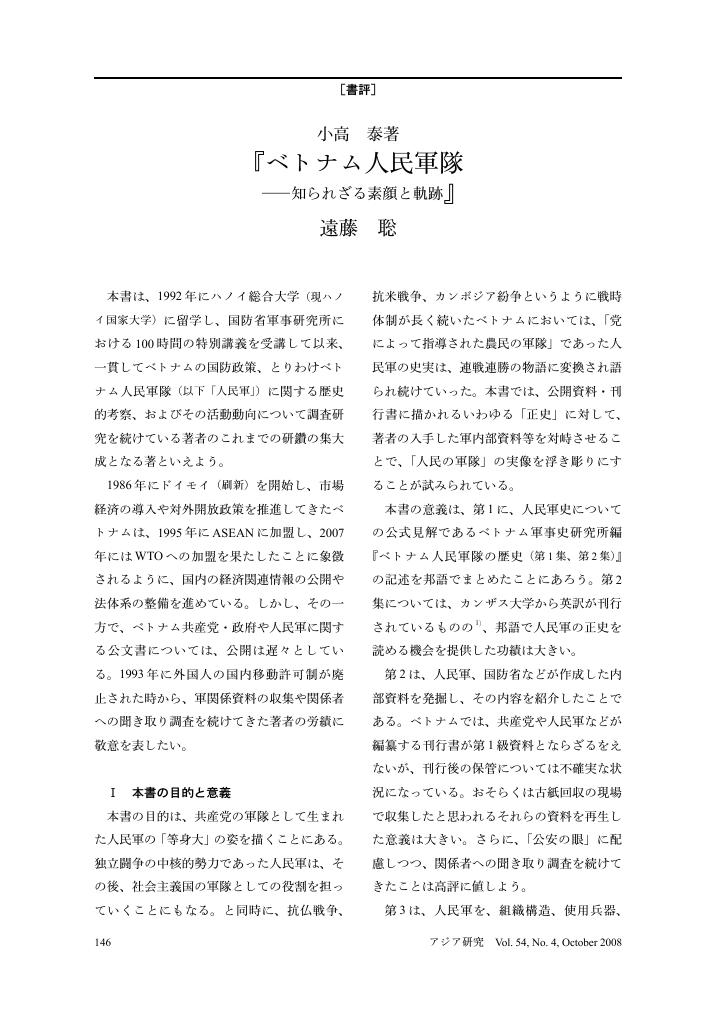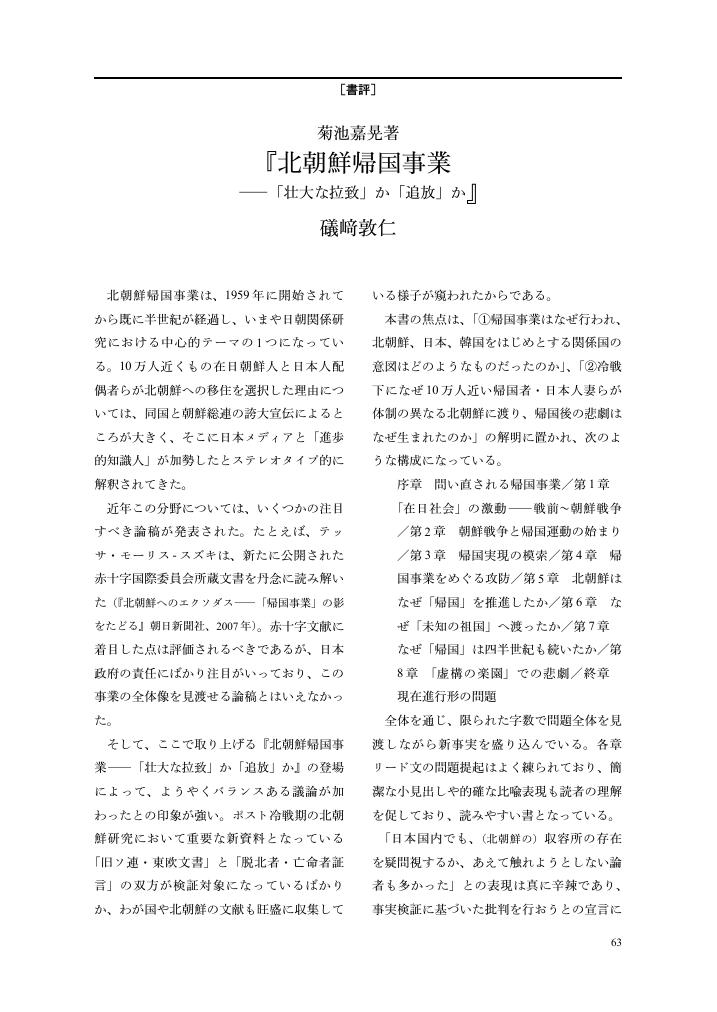6 0 0 0 OA 中国における自然改造
- 著者
- 天野 元之助
- 出版者
- 一般財団法人 アジア政経学会
- 雑誌
- アジア研究 (ISSN:00449237)
- 巻号頁・発行日
- vol.12, no.2, pp.1-20, 1965 (Released:2014-09-15)
5 0 0 0 OA 満洲国における身分証明と「日本臣民」 戸籍法、民籍法、寄留法の連繋体制
- 著者
- 遠藤 正敬
- 出版者
- 一般財団法人 アジア政経学会
- 雑誌
- アジア研究 (ISSN:00449237)
- 巻号頁・発行日
- vol.56, no.3, pp.1-11, 2010-07-31 (Released:2014-09-15)
- 参考文献数
- 28
Manchoukuo, founded in 1932 as a Japanese puppet-state, was a compound-national state, in which it was difficult to enforce nationality law and family registration (koseki) law. ‘Nation registration’ (minseki) was enforced in 1940 as an alternative institution. The governments of Japan and Manchoukuo were faced with the difficulty of how to deal with the koseki of ‘Japanese subjects’, including Japanese, Koreans and Taiwanese, and how to treat their identities in Manchoukuo–this problem was exacerbated by the increase in the population of ‘Japanese subjects’ in Manchoukuo caused by Japan’s immigration policy. Japanese colonial rule required the Japanese, Koreans and Taiwanese inhabitants of Manchoukuo to have separate registered domiciles (honseki), which reflected their respective ethnicities. Changes in this status were not generally permitted. The Japanese government implemented the policy of requiring ‘Japanese subjects’ who had registered according to minseki also to register their koseki for the purposes of convenience. Consequently ‘Japanese subjects’ in Manchoukuo had dual registered domiciles, koseki and minseki. Although Japanese and Koreans had dual identities, ‘Japanese subjects’ and ‘Manchoukuo nationals’, the governments of Japan and Manchoukuo adopted the policy that ‘Japanese subjects’ had priority over ‘Manchoukuo nationals’. Consequently, minseki were subordinate to Japanese koseki.The majority of Koreans in Manchoukuo had been omitted from Korean koseki. In 1939, The Japanese Governor-General of Korea coerced them into applying for registration. Japanese government decided to adopt conscription in Korea in 1944, and a Korean resident registration law (Chosen kiryu-rei) was enacted to register the persons who had not resided in honseki in Korean koseki.In Japan, the resident registration (kiryu) law had been in force in 1917 to register the Japanese who had resided in places other than honseki. In Manchoukuo, therefore, the honseki of ‘Manchoukuo nationals’ recorded in minseki did not match their actual places of residences. In 1943, the Manchoukuo government also enacted the kiryu law so that they could obtain the actual addresses of ‘Manchoukuo nationals’.‘Japanese subjects’ in Manchoukuo were bound by a system of triple registration. Under Japanese colonial rule, the koseki system had played an important part as a ‘safety device’ to distinguish the Japanese from the Koreans or the Taiwanese. However, the system also had the effect of determining the honseki of registrants. Consequently, the kiryu system was indispensable as a complement to the above-mentioned functions of the koseki system in the Japanese empire.
5 0 0 0 OA ミャンマーの民主化と国民統合問題における外生要因 米国公式記録に見る史実を中心として
- 著者
- 熊田 徹
- 出版者
- 一般財団法人 アジア政経学会
- 雑誌
- アジア研究 (ISSN:00449237)
- 巻号頁・発行日
- vol.47, no.3, pp.1-27, 2001 (Released:2014-09-15)
5 0 0 0 OA 中西嘉宏著『ミャンマー現代史』
- 著者
- 長田 紀之
- 出版者
- 一般財団法人 アジア政経学会
- 雑誌
- アジア研究 (ISSN:00449237)
- 巻号頁・発行日
- vol.69, no.3, pp.124-129, 2023-07-31 (Released:2023-08-19)
5 0 0 0 OA 冷戦の二日酔い
- 著者
- 藤原 帰一
- 出版者
- 一般財団法人 アジア政経学会
- 雑誌
- アジア研究 (ISSN:00449237)
- 巻号頁・発行日
- vol.39, no.2, pp.67-84, 1993 (Released:2014-09-15)
5 0 0 0 OA 東大作著『我々はなぜ戦争をしたのか―米国・ベトナム 敵との対話』
- 著者
- 遠藤 聡
- 出版者
- 一般財団法人 アジア政経学会
- 雑誌
- アジア研究 (ISSN:00449237)
- 巻号頁・発行日
- vol.47, no.1, pp.70-75, 2001 (Released:2014-09-15)
5 0 0 0 OA 中国のCOVID-19対策と「社区」
- 著者
- 飯島 渉
- 出版者
- 一般財団法人 アジア政経学会
- 雑誌
- アジア研究 (ISSN:00449237)
- 巻号頁・発行日
- vol.67, no.4, pp.58-71, 2021-10-31 (Released:2021-11-16)
- 参考文献数
- 22
The Chinese government under the control of the Chinese Communist Party selected a lockdown to control COVID-19 in the first half of 2020. The main purpose of lockdown was to restrict the activities of ordinary people including their everyday life. The transfer from Wuhan/Hebei province to other cities/provinces was under severe restrictions. The Chinese government stopped the public transportations including railway, subway, bus, ships, and private car drive in Wuhan. The mobilization inside Wuhan was also under severe regulations, to buy everyday food was also under the mobilization permit. These kinds of severe and big-scale lockdown were the first case in the history of public health.The lockdown was very effective to control COVID-19 in Wuhan, the pandemic was quite controlled in a few months. To control mobilization, the Chinese government prepared to supply much food, medical instruments for the ordinary people of Wuhan, and the central and local governments also paid much attention to support the people’s everyday life. The Chinese People’s Liberation Army was also mobilized to support the lockdown.Why did the Chinese government succeed in anti-COVID-19? In Wuhan and other Chinese urban districts, “community” (社区 She-qu) played a key role in the lockdown. The severe inspections for health conditions were advanced at the health stations in the “community” by the staff who had a close tie with the local unit of the Chinese Communist Party. A severe curfew was also advanced based on “community” and sub-“community” (小区 Xiao-qu). The origin of this method was started at the anti-SARS movement in 2003, but the digitalization of community or personal control by the advanced ITC systems, for example, the “Health Code” was one of the new key methods at the control of COVID-19 pandemic in 2020.The reality in China shows us that the “community” control is the reason why the Chinese government succeed in the control of COVID-19. The urban “community” was reorganized during the period of the privatization of the state-owned company, but only few studies discussed the role of public health. How to examine the role of “community” of China in the history of public health and the contemporary anti-epidemic measures is one of the important topics in Chinese studies and public health studies.
5 0 0 0 OA 小高 泰著 『ベトナム人民軍隊―知られざる素顔と軌跡』
- 著者
- 遠藤 聡
- 出版者
- 一般財団法人 アジア政経学会
- 雑誌
- アジア研究 (ISSN:00449237)
- 巻号頁・発行日
- vol.54, no.4, pp.146-150, 2008-10-31 (Released:2014-09-15)
5 0 0 0 OA 林泉忠著 『「辺境東アジア」のアイデンティティ・ポリティクス─沖縄・台湾・香港』
- 著者
- 金戸 幸子
- 出版者
- 一般財団法人 アジア政経学会
- 雑誌
- アジア研究 (ISSN:00449237)
- 巻号頁・発行日
- vol.51, no.4, pp.83-87, 2005-10-31 (Released:2014-09-30)
4 0 0 0 OA 民主主義指標にみるアジア諸国の民主主義の現状
- 著者
- 湊 一樹
- 出版者
- 一般財団法人 アジア政経学会
- 雑誌
- アジア研究 (ISSN:00449237)
- 巻号頁・発行日
- vol.66, no.2, pp.42-51, 2020-04-30 (Released:2020-06-09)
- 参考文献数
- 13
Against a backdrop of growing concern over democratic decline, many scholars have debated whether democracy has been in a global recession for the past decade or so. Based on two major democracy indices, this article presents how political regimes in Asian countries have changed since the mid-2000s—the period when, according to its proponents, a global democratic recession started. Both the Freedom House and Varieties of Democracy (V-Dem) measures suggest that the Asian countries that have lower scores now than in 2005 are mostly emerging democracies, but that there is no clear pattern of democratic decline across the region since the mid-2000s. Notably, there was a significant gap between the two indices for some countries, including the Philippines and India, both of which are featured in the current issue of this journal. This seems quite natural, given the different methodologies adopted by the indices to measure democracy. I conclude that country case studies are critical for assessing the extent to which democracy indices can capture the political reality of each country and for determining which index is more sensible than others.
4 0 0 0 OA 菊池嘉晃著 『北朝鮮帰国事業―「壮大な拉致」か「追放」か』
- 著者
- 礒﨑 敦仁
- 出版者
- 一般財団法人 アジア政経学会
- 雑誌
- アジア研究 (ISSN:00449237)
- 巻号頁・発行日
- vol.56, no.3, pp.63-64, 2010-07-31 (Released:2014-09-15)
4 0 0 0 OA 庄司智孝著『南シナ海問題の構図―中越紛争から多国間対立へ』
- 著者
- 黒杭 良美
- 出版者
- 一般財団法人 アジア政経学会
- 雑誌
- アジア研究 (ISSN:00449237)
- 巻号頁・発行日
- vol.69, no.1, pp.72-75, 2023-01-31 (Released:2023-02-17)
- 参考文献数
- 5
4 0 0 0 OA 一帯一路とラオスの経済関係多角化の悲願
- 著者
- ケオラ スックニラン 相澤 伸広
- 出版者
- 一般財団法人 アジア政経学会
- 雑誌
- アジア研究 (ISSN:00449237)
- 巻号頁・発行日
- vol.68, no.1, pp.41-53, 2022-01-31 (Released:2022-02-05)
- 参考文献数
- 20
As China pushes ahead with infrastructure development projects that are very large in proportion to the economies of several of its land-locked neighbors, there is bound to be concern over the social and economic ramifications of those projects. However, the progress of those large projects has not necessarily been unilaterally decided by China. Many of its neighbors are struggling in a world economy that is rapidly globalized based on opportunities created by maritime trade. For these land-locked neighbors, the rise of China since the 2000s has brought a major global market to their doorsteps. Furthermore, the Belt and Road Initiative (BRI) presents them with an unprecedented opportunity to overcome formidable geographical obstacles. This paper argues that BRI-related large-scale transportation infrastructure development in Laos is progressing in line with the intentions of Laos and China. To do so, we first examine the economic relationship between Laos and Thailand, which has the lowest geographical barriers and has been deepening with positive results for economic growth since the end of the Cold War. Nonetheless, the Asian financial crisis, which started in Thailand in 1997, made Laos acutely conscious of the risk of a catastrophe if its land-locked economy was overly dependent on a single route out of the country. That awareness prompted Laos to seek to diversify its external economic relations. Next, we show how Laos cannot dispense with the involvement of major economic powers if it plans to establish substantial economic relations with other countries in addition to Thailand. Laos has, therefore, found it particularly relevant to focus on expanding its trade and investment ties with China from the 2000s to the post-2016 era of the High Speed Railway (HSR) development. Finally, we highlight Laos’s current external debt difficulty which has been dramatically exacerbated by several large-scale projects and Covid-19 pandemic. We conclude with a discussion of how the HSR, which will be completed by the end of 2021, may contribute to the recovery of the Lao economy.
4 0 0 0 OA 南京国民政府期における中国「パンダ外交」の形成(1928–1949)
- 著者
- 家永 真幸
- 出版者
- 一般財団法人 アジア政経学会
- 雑誌
- アジア研究 (ISSN:00449237)
- 巻号頁・発行日
- vol.55, no.3, pp.1-17, 2009-07-31 (Released:2014-09-15)
- 参考文献数
- 87
- 被引用文献数
- 1
The idea that pandas are the “national symbol” of China is no more than a historically invented notion. However, even within international politics today, debates concerning whether or not these animals are “Chinese” have arisen as a political issue through their connection with the so-called “Taiwan problem” or “Tibet problem”.How is it that pandas have become embroiled in such political controversy, despite not being regarded as important for international politics from a realist perspective? In answering this question, it might be meaningful to reconsider what factors have made the Chinese state legitimate within international society. Therefore, in this article I have tried to reveal how pandas have become a Chinese national symbol, referring to the official archives of the Republic of China opened on Taipei, Nanjing, Chongqing and Chengdu.The Central Propaganda Department of the Chinese Nationalist Party first presented pandas to the USA as a part of its “propaganda diplomacy” in 1941, when this animal first became a symbol of friendship between the two countries. This paper reveals that the Nationalist regime used this “panda diplomacy” to forge friendly relations with the USA, while at the same time as attempting to show the “civilized” nature of the Chinese state. Before then, the Chinese government had taken little interest in pandas. This paper also points out that such “panda diplomacy” had been initiated between 1928 and 1949 in the following four historical contexts: (i) the rising significance of the south-west region for the Nationalist regime in the War of Resistance Against Japan; (ii) the rising consciousness of sovereignty in China that insisted that natural resources, including pandas, must be controlled by the Chinese themselves; (iii) the adaptation to the idea of animal protection which had become a criterion of civilized countries; (iv) the demand for widespread support from the US people under wartime diplomacy.In conclusion, I would like to stress that the process by which pandas became a national symbol was nothing more than a process involving China’s adaptation to international society, in which the handling of these animals had the potential of constituting a factor in China’s “external legitimacy”. I believe that this situation is still relevant in regards to the legitimacy of the Chinese state in contemporary East Asia.
4 0 0 0 OA 堀内義隆著『緑の工業化―台湾経済の歴史的起源』
- 著者
- やまだ あつし
- 出版者
- 一般財団法人 アジア政経学会
- 雑誌
- アジア研究 (ISSN:00449237)
- 巻号頁・発行日
- vol.68, no.2, pp.58-61, 2022-04-30 (Released:2022-05-24)
- 参考文献数
- 3
- 著者
- 小林 良樹
- 出版者
- 一般財団法人 アジア政経学会
- 雑誌
- アジア研究 (ISSN:00449237)
- 巻号頁・発行日
- vol.54, no.4, pp.87-108, 2008
This paper examines the hypothesis that one of the possible reasons for the recent negative perception of Japan in China is the relatively low volume of mutual human exchange between the two countries.<br>Based on an analysis of various opinion poll data, the characteristics of Chinese perceptions of Japan can be summarized as follows:<br>(1) Since the mid-1990s, the Chinese perception of Japan has been consistently negative.<br>(2) Such a negative perception of Japan is stronger in China than in other East Asian countries.<br>(3) In terms of the medium- and long-term trend since the mid-1990s, Chinese perception of Japan has continued to worsen, which is a unique phenomenon unseen in other East Asian countries including South Korea.<br>(4) Those Chinese who have experienced direct contact with the Japanese in general have a more moderate perception toward Japan than those Chinese who have not had such experience.<br>Apart from the historical fact that Japan and China have fought against each other, such a uniquely negative perception toward Japan in China can be attributed to the following reasons:<br>(1) The strengthening of patriotic education campaigns in China since the mid-1990s.<br>(2) The upsurge in anti-China perceptions in Japan since the 1990s (which are reflected back to China).<br>(3) Misperceptions and misunderstandings at an individual level in China, mainly due to the lack of objective knowledge about Japan as well as cultural differences.<br>One of the possible reasons for the misperception and misunderstanding at the individual level in China could be the relatively low volume of human exchange between China and Japan, which is still relatively low compared with the volume of exchanges between Japan and other major Asian countries.<br>For instance, Japan's "visitor-population ratio" (ratio of the number of visitors to Japan compared to the nation's population) in 2006 is as follows: China, 0.04% (one visitor per 2,500people); South Korea, 4.14% (one visitor per 24); Taiwan, 5.61% (one visitor per 18); Hong Kong, 5.04% (one visitor per 20); Singapore, 3.12% (one visitor per 32).<br>Data analysis indicates that the current negative perception of Japan in China is unique compared with similar perceptions in other East Asian countries.<br>There are several reasons for such a situation in China, and the current situation may not be due to only one reason.<br>Nevertheless, the enhancement of human exchanges between the two countries could be useful to prevent any increase in mutual misunderstanding as well as for managing any outbursts of negative feelings.
4 0 0 0 OA 無政府主義者としての劉師培
- 著者
- 嵯峨 隆
- 出版者
- 一般財団法人 アジア政経学会
- 雑誌
- アジア研究 (ISSN:00449237)
- 巻号頁・発行日
- vol.26, no.1, pp.83-106, 1979 (Released:2014-09-15)
4 0 0 0 OA 民国初年におけるアナキズム 第一世代を中心に
- 著者
- 嵯峨 隆
- 出版者
- 一般財団法人 アジア政経学会
- 雑誌
- アジア研究 (ISSN:00449237)
- 巻号頁・発行日
- vol.37, no.1, pp.35-72, 1990 (Released:2014-09-15)
4 0 0 0 OA 中国台頭症候群―香港・台湾から見た「チャイニーズ・システム」の課題
- 著者
- 林 泉忠
- 出版者
- 一般財団法人 アジア政経学会
- 雑誌
- アジア研究 (ISSN:00449237)
- 巻号頁・発行日
- vol.63, no.1, pp.48-67, 2017-01-31 (Released:2017-03-24)
- 参考文献数
- 31
The aim of this paper is to raise a new concept; namely, the “China Rise Syndrome”, which is based on the concentric spreading characteristics for analyzing the phenomena of the conflicts in four different levels due to the rise of China. The paper emphasizes the steadfast rejection of democratization under the circumstances of rapid growth of power is the origin of the syndrome. Before the rise of China, the negative influence exercised by the authoritarian CCP was only limited in mainland China. However, it has been spreading quickly to other territories outside the country while corresponding with the growth of China’s power; firstly, Hong Kong; secondly, Taiwan; thirdly, the neighboring countries with which China has sovereignty disputes over the nearby islands, and lastly, the rest of the world. In this period, CCP‘s China backed by her exponential growth of political, economic and military power tends to press severely her ideology against the challenges from the outside world, thus inducing varied conflicts. There are three major findings in this paper: Firstly, Hong Kong and Taiwan, China’s “closest peripheries”, experience interferences and threats from China much more directly and fiercely than others, and on the other hand, were also driven to the most intense rebellions. Secondly, although China claims her territorial sovereignty on both Hong Kong and Taiwan simultaneously, the speed of Chinization in Hong Kong is faster than Taiwan which is still cherishing her independence from China. Thirdly, with the Chinization phenomena in Hong Kong and Taiwan and the anti-democracy virus of China Rise running alongside, the people’s local identity and the centrifugal force away from China in both societies have been staying at the strongest in history. This paper lays stress upon the phenomena of Chinization and the rebellions against China in both Hong Kong and Taiwan are the paramount observation points in understanding how the Chinese Value, the Chinese Model, and the Chinese System in the era of China Rise spread externally, and how do they induce misgivings, tension, threats, panic and collision with the outside world and how do they influence the world order.
4 0 0 0 OA ASEAN経済共同体の創設―成果と課題
- 著者
- 石川 幸一
- 出版者
- 一般財団法人 アジア政経学会
- 雑誌
- アジア研究 (ISSN:00449237)
- 巻号頁・発行日
- vol.62, no.3, pp.21-37, 2016-04-30 (Released:2016-08-24)
- 参考文献数
- 41











